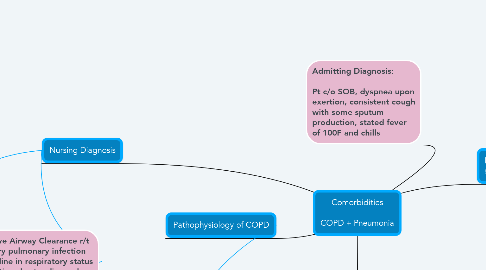Comorbidities COPD + Pneumonia
by Lance Mollenkamp

1. Nursing Diagnosis
2. Pathophysiology of COPD
3. COPD - Chronic Obstructive Pulmonary Disorder is a disease of two specific types, being the chronic bronchitis (continued exacerbations of inflammation and constriction of the bronchi thus decreasing airway clearance) and of the emphysema type (in which the alveoli are continuously damaged over time and gas exchange and transfer declines and the sacs fill with fluid, precipitating an infection. Pneumonia is one of the most common infections for patients with long term COPD diagnosis
4. Ineffective Airway Clearance r/t secondary pulmonary infection AEB decline in respiratory status and positive chest radiograph with pulmonary infiltrates
5. Interventions for Diagnosis #2 Monitor and Assess WOB, lung sounds anterior and posterior bilaterally encourage coughing, deep breathing, turning, and incentive spirometry to facilitate clearance of sputum offer education and facilitate understanding of breathing technique teaching like pursed lip breathing, or diaphragmatic breathing at home to lessen exacerbations and infections ecourage fluids and hydration to thin secretions
6. Impaired Gas Exchange r/t consolidation and fluid filled alveoli AEB positive chest x-ray and diminished breath sounds A+P bilat in lower lobes
7. Interventions for Diagnosis #1 Monitor VS for deviations from baseline Assess pt for worsening respiratory effort, or signs and symptoms of hypoxia constant measuring of SpO2 % via pulse oximeter with a goal of >94% during hospital admission Assess for signs of decline in LOC compared to baseline, this can be done through effective handoff between shifts by the nurses for pt if long term stay is required Monitor and interpret ABG levels
8. Expected Outcomes for Patient Patient maintains a proficient gas exchange with SpO2 >95% with breath sounds improving in all fields through entirety of hospital admission and upon completion of antibiotic therapy, ABGs monitored for no adverse findings associated with bacteremia or respiratory compromise Patient respiratory effort and WOB improve throughout admission and the patient verbalizes and demonstrates proper breathing techniques to prevent further infection probability and understands the importance of continuing antibiotic therapy post discharge from hospital
9. Admitting Diagnosis: Pt c/o SOB, dyspnea upon exertion, consistent cough with some sputum production, stated fever of 100F and chills
10. Presentation of patient symptoms
11. Shortness of breath diminished breath sounds crackles in bases of lungs dyspnea upon exertion decreased LOC SpO2 <94% Fever, tachycardia, tachypnea wheezes upon inspiration
12. Precipitating factors for Pneumonia in COPD pt
13. Medications likely administered for current patient stay
14. Patient has poor pulmonary expansion with resulting air trapping in the alveoli, thus while fluid and air remain in the space, bacterial infiltrates may grow and have a breeding ground to result into bacterial pneumonia which in older populations may first express as LOC changes as infection worsens
15. Laboratory/Radiology Tests for Pneumonia Confirmation
16. Radiology Chest X-Ray for positive consolidation within the lung fields and to identify which lobes effected A CBC done to identify the WBC and Neutrophil count as well as H&H for positive infection ABGs to detect if patient is acidotic or is being compromised due to the infection secondary to poor gas exchange from COPD exacerbation
17. Appropriate Oxygen Gas to bring the patient saturation >95% Lung Selective Beta Agonists (typically Albuterol) to provide immediate relief and lessened WOB to the patient A Corticosteroid for continued anti-inflammatory effect for a longer term (typically Prednisone /Methylprednisone) After blood work and or sputum sample has been acquired a specfic antibiotic selected that will be most lethal to the infection secondary to the COPD exacerbation (Vanomycin/ Amoxicillin/ Doxycycline)


